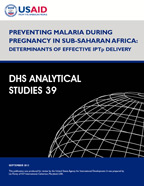- PUBLICATIONS
- JOURNAL ARTICLES
- ORDER PUBLICATIONS
Publications Summary
- Document Type
- Analytical Studies
- Publication Topic(s)
- Malaria
- Country(s)
- Burkina Faso, Burundi, Cameroon, Congo Democratic Republic, Ghana, Kenya, Madagascar, Malawi, Mozambique, Nigeria, Senegal, Sierra Leone, Tanzania, Uganda, Zambia, Zimbabwe
- Language
- English
- Recommended Citation
- Florey, Lia. 2013. Preventing Malaria During Pregnancy in Sub-Saharan Africa: Determinants of Effective IPTp Delivery. DHS Analytical Studies No. 39. Calverton, Maryland, USA: ICF International.
- Download Citation
- RIS format / Text format / Endnote format
- Publication Date
- September 2013
- Publication ID
- AS39
Download
 Preventing Malaria during Pregnancy in Sub-Saharan Africa: Determinants of Effective IPTp Delivery (PDF, 2165K)
Preventing Malaria during Pregnancy in Sub-Saharan Africa: Determinants of Effective IPTp Delivery (PDF, 2165K)
